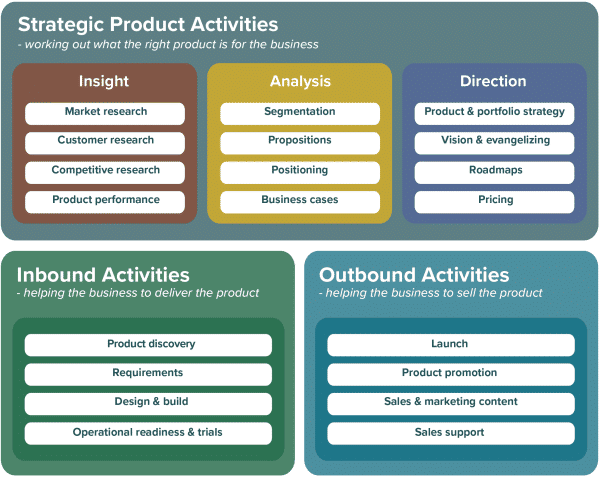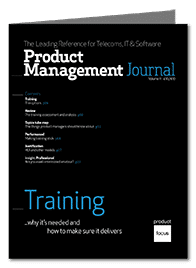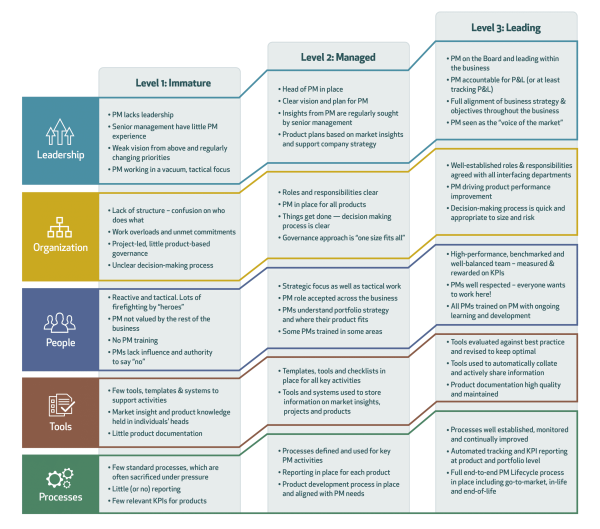If you ask product managers from different businesses to talk about what they do, their answers vary widely. Some of this is down to the products they manage, but often it’s down to what a company wants from their product management team, and how things have evolved.
A pre-training needs assessment can help to understand the purpose of product management at a business and identify issues affecting the performance of the team. Training can then be tailored to focus on the most important areas.
However, sometimes there are more fundamental issues worrying a company. In these instances, it can make sense to start with a full and comprehensive product management review.
You can read all the articles in our Product Management Journal – Training by signing up for free here.
Reviews
One of the tools we use to review a company’s product management function is our Product Activities Framework.

This looks at all the key product management activities that take place in a business (that sells products) and divides them into 3 main areas. We then work through a process to understand what product managers own, what is picked up by other teams, and how effective the activity is within the business. The example above shows a RAG (Red, Amber, Green) status for how well each activity is done in an example company.
Another tool we use is our Product Management (PM) Maturity Model below. This model examines how well product management and product marketing works within a business by looking at the behavior, structure, and processes that exist.
Have a look at the model to decide where you and your company fit? When we first see companies, most rate themselves between levels 1 and 2. Few companies fully achieve level 3, although many find it a useful objective. Our experience is that a company’s level changes up and down over time, and the ‘ups’ often relate to the level of support Product Management has from the senior management team.
Examining the role of product managers
One other approach we use to clarify how product management is working in a business is to ask a company what they believe the role of a product manager should be.
The answers we get usually fall somewhere between the two roles described below. The first is more strategic, and the second more tactical; however, we believe both can be appropriate and successful within a business.
Product managers as the mini-CEO
One of the common ‘mental models’ for Product Management is to act as though they are the CEO for their product line within the business. It’s a useful model that engenders accountability, and a passion to deliver. It gives permission to get involved in any area of the business that is affecting product performance.
The mini-CEO sets objectives and strategy for their products and provides drive and vision for the rest of the business. It’s a leadership role that positions products at the center of bringing the business strategy to life.
The mini-CEO is also the escalation point, making decisions, priority calls, and compromises in support of their strategy. Typically they act like traffic lights when a new issue comes in. They triage the problem, find an owner within the business, and chase it through to resolution. The aim is to find a permanent home for issues so that if they recur, they can be routed to the right person without taking up too much of the product manager’s time.
The reality is that product managers don’t have the authority of a CEO to change priorities, re-allocate scarce money, or command people to do their bidding. Nevertheless, good ones have the skills and gravitas to wield enormous influence on the rest of the business.
Product managers as the ‘go-to’ person
We often hear companies saying they want their product managers to be the ‘go-to’ people. What this usually means is that when something (usually anything) goes wrong, all eyes turn to the product manager to sort it out. It’s a tactical role. Their purpose is to put out fires and keep things moving smoothly.
Product Managers are well placed to take this on. While they may not have the depth of knowledge about the market and propositions as some in the business, they will have the broadest expertise about their product. We often find product managers take on this role in less mature organizations. They tend to do much of the work themselves just to get things done, and because there is no-one else to do it. The danger is that as products become successful, they find that working in this way doesn’t scale well.
The ideal role
As a discipline, product management is evolving and maturing. We believe it’s at its best when it …
- Provides a balanced view for the business. Making or recommending ‘objective’ decisions based on balanced insight into operational, technical, and commercial issues.
- Is leading rather than responding. Less firefighting and more guiding strategy based on market insights, i.e., getting off the back-foot and onto the front-foot.
- Is driving product performance. Tracking key metrics against agreed objectives to deliver business success.
Conclusion
An in-depth review of product management prior to training can make sure you maximize the effectiveness of any course. In addition, as businesses change it’s common to find that no-one has recently examined what the optimal set-up for product management should be. A review can help establish effective structures, roles, and best practice for the whole product management function.



